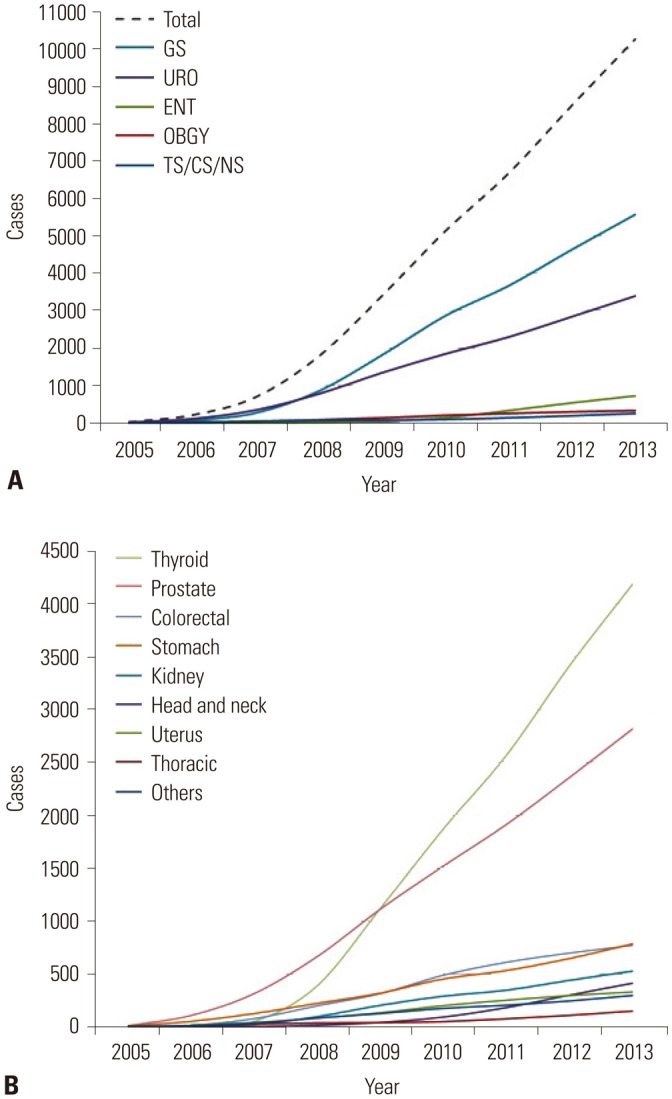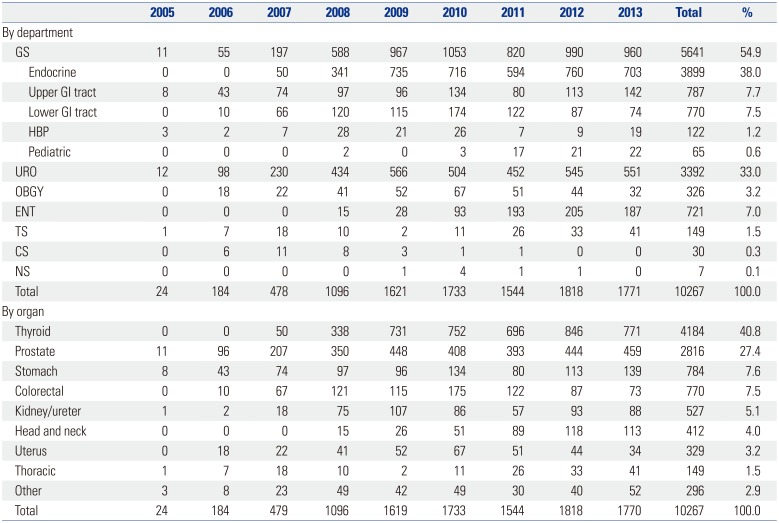1. Kim CW, Kim CH, Baik SH. Outcomes of robotic-assisted colorectal surgery compared with laparoscopic and open surgery: a systematic review. J Gastrointest Surg. 2014; 18:816–830. PMID:
24496745.

2. Kim YT, Kim SW, Jung YW. Robotic surgery in gynecologic field. Yonsei Med J. 2008; 49:886–890. PMID:
19108009.

3. Lee YS, Han WK, Oh YT, Choi YD, Yang SC, Rha KH. Robot-assisted laparoscopic radical prostatectomy: four cases. Yonsei Med J. 2007; 48:341–346. PMID:
17461539.

4. Yu HY, Friedlander DF, Patel S, Hu JC. The current status of robotic oncologic surgery. CA Cancer J Clin. 2013; 63:45–56. PMID:
23161385.

5. Intuitive Surgical Inc. Annual report 2013. Sunnyvale (CA): Intuitive Surgical Inc.;2013.
6. Kang CM, Chi HS, Hyeung WJ, Kim KS, Choi JS, Lee WJ, et al. The first Korean experience of telemanipulative robot-assisted laparoscopic cholecystectomy using the da vinci system. Yonsei Med J. 2007; 48:540–545. PMID:
17594166.

7. Choi SB, Park JS, Kim JK, Hyung WJ, Kim KS, Yoon DS, et al. Early experiences of robotic-assisted laparoscopic liver resection. Yonsei Med J. 2008; 49:632–638. PMID:
18729307.

8. Park SY, Cho KS, Ham WS, Choi HM, Hong SJ, Rha KH. Robot-assisted laparoscopic radical cystoprostatectomy with ileal conduiturinary diversion: initial experience in Korea. J Laparoendosc Adv Surg Tech A. 2008; 18:401–404. PMID:
18503374.
9. Park SY, Jeong W, Choi YD, Chung BH, Hong SJ, Rha KH. Yonsei experience in robotic urologic surgery-application in various urological procedures. Yonsei Med J. 2008; 49:897–900. PMID:
19108011.
10. Ham WS, Park SY, Rha KH, Kim WT, Choi YD. Robotic radical prostatectomy for patients with locally advanced prostate cancer is feasible: results of a single-institution study. J Laparoendosc Adv Surg Tech A. 2009; 19:329–332. PMID:
19397390.

11. Park SY, Jeong W, Ham WS, Kim WT, Rha KH. Initial experience of robotic nephroureterectomy: a hybrid-port technique. BJU Int. 2009; 104:1718–1721. PMID:
19519762.

12. Kang SW, Lee SH, Ryu HR, Lee KY, Jeong JJ, Nam KH, et al. Initial experience with robot-assisted modified radical neck dissection for the management of thyroid carcinoma with lateral neck node metastasis. Surgery. 2010; 148:1214–1221. PMID:
21134554.

13. Kim DH, Kang CM, Lee WJ, Chi HS. The first experience of robot assisted spleen-preserving laparoscopic distal pancreatectomy in Korea. Yonsei Med J. 2011; 52:539–542. PMID:
21488201.

14. Lee DH, Jung HB, Chung MS, Lee SH, Chung BH. The change of prostate cancer treatment in Korea: 5 year analysis of a single institution. Yonsei Med J. 2013; 54:87–91. PMID:
23225803.

15. Lee JY, Diaz RR, Cho KS, Yu HS, Chung JS, Ham WS, et al. Lymphocele after extraperitoneal robot-assisted radical prostatectomy: a propensity score-matching study. Int J Urol. 2013; 20:1169–1176. PMID:
23521086.

16. Borden LS Jr, Kozlowski PM, Porter CR, Corman JM. Mechanical failure rate of da Vinci robotic system. Can J Urol. 2007; 14:3499–3501. PMID:
17466155.
17. Lavery HJ, Thaly R, Albala D, Ahlering T, Shalhav A, Lee D, et al. Robotic equipment malfunction during robotic prostatectomy: a multi-institutional study. J Endourol. 2008; 22:2165–2168. PMID:
18811574.

18. Ham WS, Park SY, Yu HS, Choi YD, Hong SJ, Rha KH. Malfunction of da Vinci robotic system--disassembled surgeon's console hand piece: case report and review of the literature. Urology. 2009; 73:209.e7–209.e8.

19. Kim WT, Ham WS, Jeong W, Song HJ, Rha KH, Choi YD. Failure and malfunction of da Vinci Surgical systems during various robotic surgeries: experience from six departments at a single institute. Urology. 2009; 74:1234–1237. PMID:
19716587.

20. Warren H, Dasgupta P. The future of robotics. Investig Clin Urol. 2017; 58:297–298.

24. Jung KW, Won YJ, Kong HJ, Oh CM, Lee DH, Lee JS. Cancer statistics in Korea: incidence, mortality, survival, and prevalence in 2011. Cancer Res Treat. 2014; 46:109–123. PMID:
24851102.

25. Lee J, Chung WY. Robotic surgery for thyroid disease. Eur Thyroid J. 2013; 2:93–101. PMID:
24783046.

26. Kang SW, Jeong JJ, Yun JS, Sung TY, Lee SC, Lee YS, et al. Gasless endoscopic thyroidectomy using trans-axillary approach; surgical outcome of 581 patients. Endocr J. 2009; 56:361–369. PMID:
19139596.

27. Kim MJ, Nam KH, Lee SG, Choi JB, Kim TH, Lee CR, et al. Yonsei experience of 5000 gasless transaxillary robotic thyroidectomies. World J Surg. 2018; 42:393–401. PMID:
28879559.

28. Kang SW, Jeong JJ, Yun JS, Sung TY, Lee SC, Lee YS, et al. Robot-assisted endoscopic surgery for thyroid cancer: experience with the first 100 patients. Surg Endosc. 2009; 23:2399–2406. PMID:
19263137.

29. Park JH, Lee CR, Park S, Jeong JS, Kang SW, Jeong JJ, et al. Initial experience with robotic gasless transaxillary thyroidectomy for the management of graves disease: comparison of conventional open versus robotic thyroidectomy. Surg Laparosc Endosc Percutan Tech. 2013; 23:e173–e177. PMID:
24105290.
30. Jung JH, Seo JW, Lim MS, Lee JW, Chung BH, Hong SJ, et al. Extended pelvic lymph node dissection including internal iliac packet should be performed during robot-assisted laparoscopic radical prostatectomy for high-risk prostate cancer. J Laparoendosc Adv Surg Tech A. 2012; 22:785–790. PMID:
22967037.

31. Kim KH, Lim SK, Kim HY, Shin TY, Lee JY, Choi YD, et al. Extended vs standard lymph node dissection in robot-assisted radical prostatectomy for intermediate- or high-risk prostate cancer: a propensity-score-matching analysis. BJU Int. 2013; 112:216–223. PMID:
23356436.

32. Lee JY, Cho KS, Kwon JK, Jeh SU, Kang HW, Diaz RR, et al. A competing risk analysis of cancer-specific mortality of initial treatment with radical prostatectomy versus radiation therapy in clinically localized high-risk prostate cancer. Ann Surg Oncol. 2014; 21:4026–4033. PMID:
24841351.

33. Lee JY, Lee DH, Cho NH, Rha KH, Choi YD, Hong SJ, et al. Impact of Charlson comorbidity index varies by age in patients with prostate cancer treated by radical prostatectomy: a competing risk regression analysis. Ann Surg Oncol. 2014; 21:677–683. PMID:
24145996.

34. Ha JY, Kim BH, Park CH, Kim CI. Early experience with active surveillance in low-risk prostate cancer treated. Korean J Urol. 2014; 55:167–171. PMID:
24648870.

35. Cho S, Kang SH. Current status of cryotherapy for prostate and kidney cancer. Korean J Urol. 2014; 55:780–788. PMID:
25512811.

36. Abdel Raheem A, Kim DK, Santok GD, Alabdulaali I, Chung BH, Choi YD, et al. Stratified analysis of 800 Asian patients after robot-assisted radical prostatectomy with a median 64 months of follow up. Int J Urol. 2016; 23:765–774. PMID:
27388671.

37. Jang WS, Kim MS, Jeong WS, Chang KD, Cho KS, Ham WS, et al. Does robot-assisted radical prostatectomy benefit patients with prostate cancer and bone oligometastases? BJU Int. 2018; 121:225–231. PMID:
28834084.

38. Vizcaino AP, Moreno V, Bosch FX, Muñoz N, Barros-Dios XM, Borras J, et al. International trends in incidence of cervical cancer: II. Squamous-cell carcinoma. Int J Cancer. 2000; 86:429–435. PMID:
10760834.

39. Parkin DM, Bray F, Ferlay J, Pisani P. Global cancer statistics, 2002. CA Cancer J Clin. 2005; 55:74–108. PMID:
15761078.

40. Tapper AM, Hannola M, Zeitlin R, Isojärvi J, Sintonen H, Ikonen TS. A systematic review and cost analysis of robot-assisted hysterectomy in malignant and benign conditions. Eur J Obstet Gynecol Reprod Biol. 2014; 177:1–10. PMID:
24703710.

41. Buchs NC, Pugin F, Volonté F, Morel P. Reliability of robotic system during general surgical procedures in a university hospital. Am J Surg. 2014; 207:84–88. PMID:
24090485.

42. Andonian S, Okeke Z, Okeke DA, Rastinehad A, Vanderbrink BA, Richstone L, et al. Device failures associated with patient injuries during robot-assisted laparoscopic surgeries: a comprehensive review of FDA MAUDE database. Can J Urol. 2008; 15:3912–3916. PMID:
18304403.
43. Veeratterapillay R, Addla SK, Jelley C, Bailie J, Rix D, Bromage S, et al. Early surgical outcomes and oncological results of robot-assisted partial nephrectomy: a multicentre study. BJU Int. 2017; 120:550–555. PMID:
27988978.

44. Gomes MTV, Costa Porto BTD, Parise Filho JP, Vasconcelos AL, Bottura BF, Marques RM. Safety model for the introduction of robotic surgery in gynecology. Rev Bras Ginecol Obstet. 2018; 40:397–402. PMID:
29775973.

45. Jung KW, Won YJ, Kong HJ, Oh CM, Lee DH, Lee JS. Cancer statistics in Korea: incidence, mortality, survival, and prevalence in 2011. Cancer Res Treat. 2014; 46:109–123. PMID:
24851102.








 PDF
PDF ePub
ePub Citation
Citation Print
Print





 XML Download
XML Download